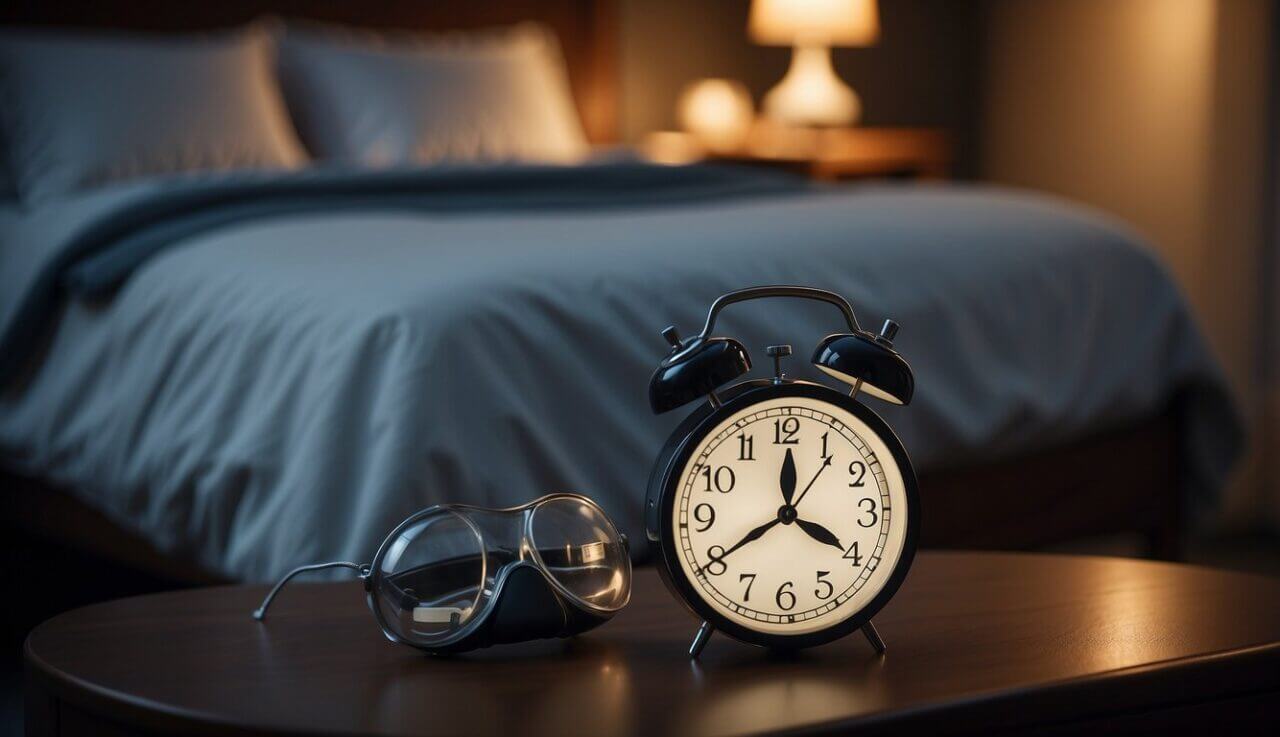5 Lifestyle Changes to Improve Sleep Apnea Symptoms: Effective Strategies for Better Sleep
If you’re battling sleep apnea, you already know how disruptive it can be to your life. It impacts your energy, your focus, and your overall health.
You’ll learn about five lifestyle changes that could make a big difference in managing your sleep apnea symptoms.
Each change is manageable and rooted in practical steps. You’ll find that with some commitment, improving your sleep quality is comfortably within your reach.
1. Lose Excess Weight

Shedding extra pounds can significantly improve your sleep apnea symptoms. Excess fat, especially around your neck, can block your airway during sleep. This makes it harder to breathe and can lead to more frequent apnea episodes.
Losing weight reduces the pressure on your airway. Even a small reduction in weight can make a noticeable difference. Aim for sustainable weight loss through a balanced diet and regular exercise.
A healthy diet is crucial. Focus on eating whole foods like fruits, vegetables, lean proteins, and whole grains. Avoid processed foods and high-sugar snacks that can lead to weight gain.
Incorporate physical activity into your daily routine. Regular exercise helps burn calories and build muscle. It also promotes better sleep quality, which can further improve your condition.
Consider consulting a nutritionist or personal trainer. They can tailor a plan specific to your needs and help you stay on track. Making these changes can lead to a healthier lifestyle and better sleep.
Remember, the goal is not just to lose weight but to maintain it. Consistent effort over time will yield the best results. Stay committed and patient with your journey.
2. Exercise Regularly

Incorporating regular exercise into your routine can significantly improve sleep apnea symptoms. Physical activity helps you maintain a healthy weight, which is crucial since excess weight can contribute to airway obstruction.
Aim for at least 30 minutes of moderate aerobic exercise a day. Activities like brisk walking, cycling, or swimming are excellent choices. Even light activities, like stretching or yoga, can make a difference.
Exercise strengthens the muscles around your airways, making them less likely to collapse during sleep. It’s also known to reduce inflammation, which can help keep your airways clear.
Regular exercise can improve your overall cardiovascular health. This is important because many people with sleep apnea also have heart-related issues. Better heart health can lead to better sleep quality.
Consistency is key. Try to stick to a regular exercise schedule, even on busy days. It’s not just about intense workouts; even small bursts of activity throughout the day can add up.
Preventing sleep apnea symptoms might seem challenging, but regular exercise is a powerful tool. It’s essential for your overall health and well-being.
3. Avoid Alcohol and Smoking

Alcohol can relax your throat muscles, causing your airway to collapse more easily during sleep. This leads to increased sleep apnea symptoms. Steering clear of alcohol, especially in the evening, might help you keep your airway open.
Smoking irritates the airways and can cause inflammation. This inflammation can narrow your airways, making it harder to breathe at night. Quitting smoking can reduce this swelling and improve breathing patterns.
Nicotine in cigarettes can also disrupt your sleep cycles. It‘s a stimulant that interferes with your ability to fall and stay asleep. By avoiding nicotine, you may find it easier to get a restful night’s sleep.
Cutting out these substances can be challenging. Consider seeking support from friends, family, or professionals. Your body will thank you for making these changes.
4. Adopt a Consistent Sleep Schedule

Going to bed and waking up at the same time every day can make a big difference. Your body’s internal clock, or circadian rhythm, thrives on regularity. By sticking to a set schedule, you help regulate that rhythm, which can improve your sleep quality.
Consistency is key. Aim to go to bed and get up at the same time, even on weekends. This helps reinforce your sleep-wake cycle.
If you struggle with getting to sleep, creating a bedtime routine can be beneficial. This might include activities like reading, gentle stretching, or meditation to signal to your body that it’s time to wind down.
Limit activities in your bedroom to sleep and relaxation. Reserve your bed for sleep to create a mental association between your bed and restfulness.
Using electronic devices before bed can disrupt your sleep schedule. The blue light emitted by screens can interfere with your body’s natural melatonin production, making it harder to fall asleep.
Try to avoid heavy meals and caffeine close to bedtime. These can cause discomfort or restlessness, making it difficult to maintain your sleep schedule.
If you have trouble adjusting, be patient. Making these changes can take time, but consistency and a little patience can lead to meaningful improvements in your sleep apnea symptoms.
5. Adjust Your Sleep Position
Changing the way you sleep can make a big difference. Sleeping on your back often worsens sleep apnea. Your tongue and soft tissues can fall back, blocking your airway.
Try sleeping on your side. This position can help keep your airway more open. You may notice you breathe easier at night.
Using pillows can help keep you in a side-sleeping position. Special pillows are available that support your neck and align your spine.
Some people also use devices that prevent them from rolling onto their back. These can be simple straps or more advanced gadgets.
Experiment with different positions to see what works best for you. Comfort is key to maintaining any new sleep habit.
Elevating your head slightly may also provide relief. Use a wedge pillow or an adjustable bed.
Avoid sleeping on your stomach. Although it might seem like a good idea, it can strain your neck and spine, causing discomfort.
Understanding Sleep Apnea
Sleep apnea is a common sleep disorder impacting your breathing. It’s essential to know what it is, its causes, and the different types.
What Is Sleep Apnea?
Sleep apnea is a condition where your breathing stops and starts repeatedly while you sleep. These interruptions can last from a few seconds to minutes and can occur multiple times per night.
The most common signs include loud snoring, gasping for air, and feeling tired even after a full night’s sleep.
This condition often goes undiagnosed because it occurs during sleep. It’s important to recognize the symptoms and consult a healthcare professional if you suspect you have sleep apnea.
Causes and Risk Factors
Several factors contribute to sleep apnea. Being overweight is a significant risk factor due to increased fat deposits around your upper airway. Other causes include narrow airways, nasal congestion, and a family history of sleep apnea.
Men are more likely to develop this condition than women. Older age and use of alcohol or sedatives can also increase your risk. Understanding these factors can help you take preventive measures.
Types of Sleep Apnea
There are three main types:
- Obstructive Sleep Apnea (OSA): The most common type, caused by a blockage of the airway, usually when the soft tissue in the back of your throat collapses.
- Central Sleep Apnea (CSA): Occurs when your brain fails to send the proper signals to the muscles controlling breathing.
- Complex Sleep Apnea Syndrome: A combination of OSA and CSA, also known as treatment-emergent central sleep apnea.
Identifying the type of sleep apnea you have is crucial for developing an effective treatment plan.
Impact of Lifestyle on Sleep Apnea
Adopting specific lifestyle changes can significantly ease the symptoms of sleep apnea. These adjustments target key areas contributing to the condition and improve overall well-being.
How Lifestyle Changes Can Help
A number of lifestyle changes can positively influence sleep apnea. Weight loss is crucial, as excess weight can cause airway blockages.
Regular exercise can enhance respiratory strength and efficiency, aiding in better sleep patterns. Reducing alcohol intake helps keep throat muscles intact, preventing airway collapse.
By changing your sleep position, such as sleeping on your side, you’ll likely see a reduction in apnea events. Quitting smoking is essential since smoking inflames the airways and can worsen the condition.
Scientific Evidence Supporting Lifestyle Adjustments
Scientific research supports these lifestyle interventions. Studies demonstrate that even modest weight loss can reduce sleep apnea’s severity by decreasing fatty deposits around the neck.
Regular exercise has been shown to strengthen respiratory muscles and improve sleep quality, even without significant weight loss. Reduced alcohol consumption correlates with fewer apnea events because of its muscle-relaxing effects.
Research confirms that sleeping on your side can reduce the number and severity of apneic events. Studies also link smoking cessation to reduced airway inflammation and better overall airway function.
By aligning your lifestyle with these scientifically-backed changes, you can make a substantial difference in managing and improving your sleep apnea symptoms.
Implementing Lifestyle Changes
Taking control of sleep apnea involves practical steps and a committed approach. Focus on goal-setting, tracking your progress, and tackling common obstacles.
Setting Realistic Goals
Start by defining clear, achievable goals. Make a list of your main objectives. Aim to lose a specific number of pounds if weight loss is part of your plan. Break big goals into smaller, manageable tasks.
For example, if weight loss is essential, target losing 1-2 pounds per week. Combine diet changes and regular exercise. Ensure your changes are sustainable, not drastic. Being realistic prevents burnout and keeps motivation high.
Monitoring Your Progress
Track your improvements regularly. Use a journal or an app to record sleep patterns, dietary changes, and exercise routines. Note any reductions in apnea events or improvements in overall sleep quality.
Apps like SleepCycle or Fitbit can provide detailed sleep analysis. Reflect on your data weekly or monthly to see what’s working. Adjust your strategies based on this feedback. Monitoring keeps you informed and helps fine-tune your approach.
Overcoming Common Challenges
Dealing with sleep apnea improvements is not without hurdles. Manage night-time awakenings with a consistent sleep schedule. If lifestyle changes are overwhelming, implement one change at a time.
Use reminders to stay on track with exercises or dietary adjustments. Join a support group for motivation and advice. Face challenges head-on and remember that gradual progress is still progress.
Every small step contributes to better sleep health.


